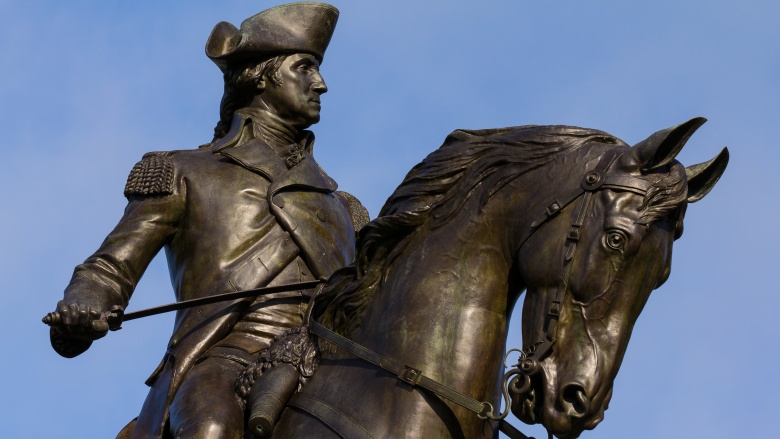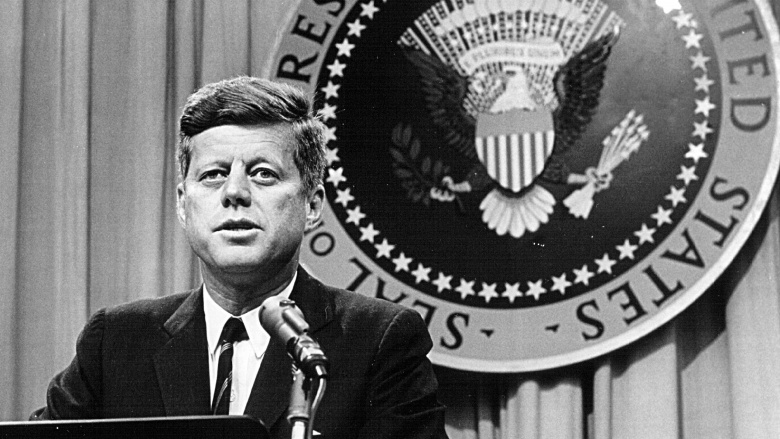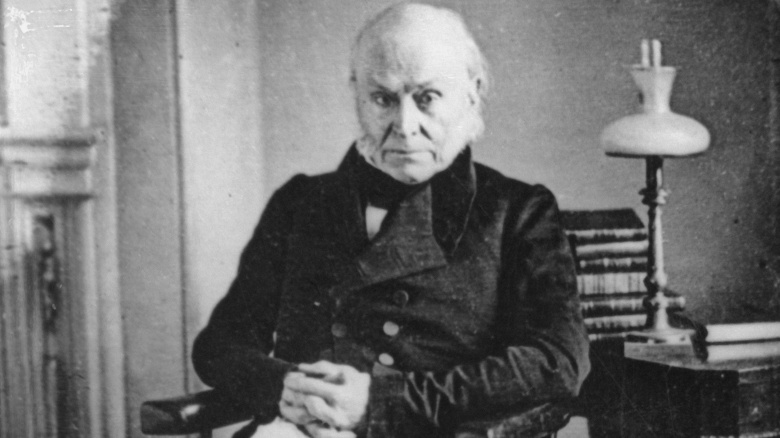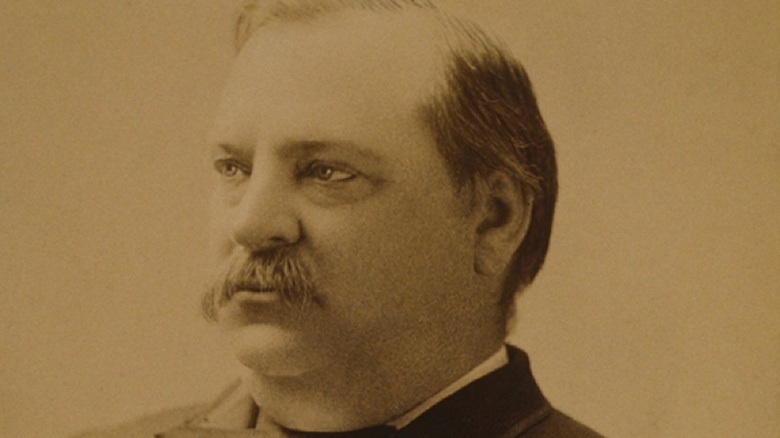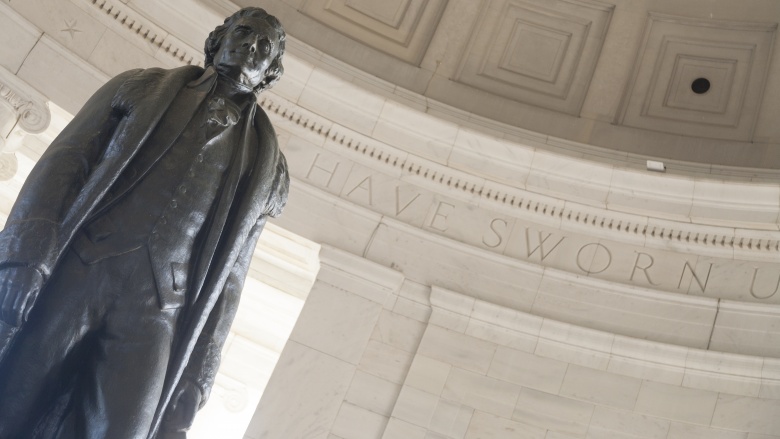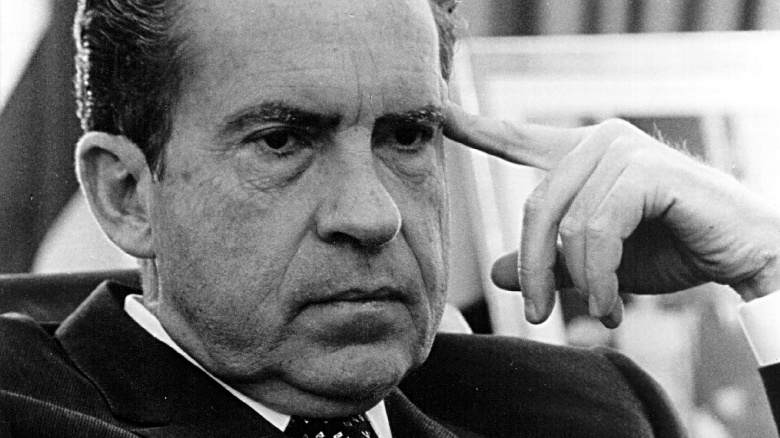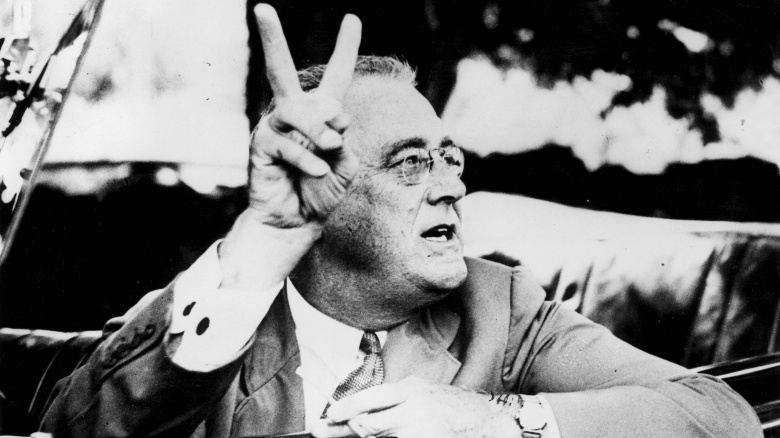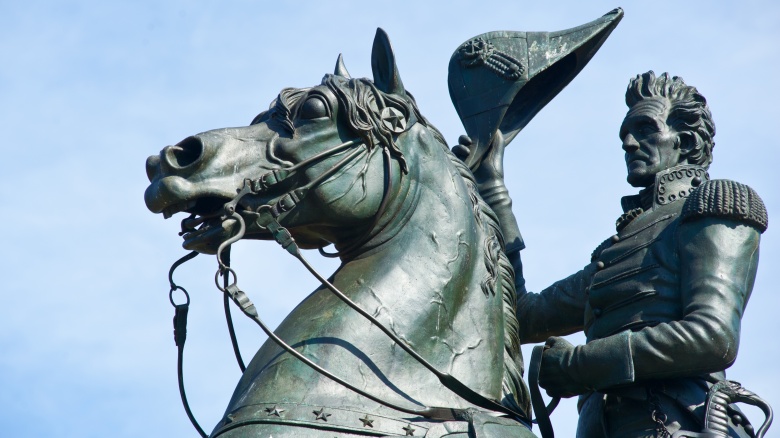Disturbing Facts About American Presidents
When learning about US presidents, most students only hear the uplifting parts, but despite what the textbooks say, presidential history isn't all fireworks and bald eagles. There are quite a few skeletons in the White House closet, from terrible tragedies to disturbing decisions. As it turns out, being commander-in-chief is one macabre job.
George Washington was almost a zombie
George Washington lived an amazing life. He was commander of the Revolutionary Army, oversaw the creation of the US Constitution, and became the nation's first president. And after his death, he was almost turned into a zombie.
The nightmarish affair began on December 13, 1799, when Washington came down with cold-like symptoms. Soon, he was struggling to breathe, and three physicians were summoned to his bedside. Over the next several hours, the doctors did their best, but in 1799, that was tantamount to torture. Washington was given an enema, followed by a concoction that made him vomit violently. Spanish fly was applied to his limbs and throat. Even worse, the physicians drained over 80 ounces of the president's blood.
The cures were worse than the illness, and Washington passed away on December 14. However, a fourth physician, William Thornton, had a rather unorthodox idea. Arriving after Washington's death, Thornton wondered if he could resurrect the president. First, he would rub Washington's corpse with blankets. Then, after performing a tracheotomy, he would use a bellows to fill the president's lung with oxygen. Finally, Thornton would pump the body full of lamb's blood.
Surprisingly, there was a method to Thornton's madness. As he pointed out, Washington "died by the loss of blood and the want of air. Restore these with the heat that had subsequently been deducted, and...his restoration was possible." Plus, quite a few doctors back in the day thought lamb's blood really could rejuvenate the body. Still, Washington's family passed on the offer, preferring to let the dead stay dead.
JFK's missing brain
Even though it happened over 50 years ago, JFK's assassination is still one of the most controversial moments in American history. Some people claim Lee Harvey Oswald acted alone. Others say Kennedy was murdered by the Mafia or the CIA or extraterrestrials or the extraterrestrial Mafia. But whatever your opinion, we can all agree a lot of disturbing stuff went on that day in Dallas.
For example, when Dallas County medical examiner Earl Rose tried to perform an autopsy on the president's body, the corpse was forcibly removed by federal officials. When the actual autopsy was performed at Bethesda National Naval Medical Center in Maryland, the doctors did a really sloppy job, failing to properly examine wounds or analyze the president's clothing. And while that might add fuel to the conspiracy theory fire, it pales in comparison to what happened to JFK's brain.
After the autopsy, the president's brain was put inside a stainless-steel cylinder, which was then stored inside a foot locker. The box also contained Kennedy's blood and tissue samples, and all this evidence was stashed away in the National Archive. But three years later, officials discovered the locker was gone. All those autopsy slides and bone fragments had disappeared, right along with the brain. While no one knows what happened to the box, there has to be a perfectly reasonable answer ... or maybe it was those damn alien mobsters.
John Quincy Adams was all-in on the Hollow Earth theory
John Quincy Adams wasn't a great president, as evidenced by that time he got swept up in one of the craziest theories in history.
It all started with a guy named John Cleves Symmes, an Army officer with some pretty weird ideas about how the world worked. According to Symmes, the Earth was hollow, and full of concentric spheres. Symmes believed if you traveled up to the Arctic, you could crawl down between all those spheres and make your way to the center of the Earth.
Most people found this theory laughable, but Symmes dedicated his life to the cause. He gave lectures across the country, sent leaflets to scientists and professors, and with the help of a wealthy backer, begged Congress to fund an expedition. His plan was to take 100 volunteers and a couple of reindeer-drawn sleds to the Arctic where he would find an opening in the ice and go all Jules Verne. As you might expect, Congress said no. However, when John Quincy Adams heard of the expedition, he overrode the legislature and gave Symmes the presidential stamp of approval.
Perhaps Adams just wanted someone to go explore the Arctic. Or maybe he really was curious about the man's theory. Either way, it didn't matter because, when Andrew Jackson was elected president, he scrapped the entire mission. When Andrew Jackson is the sane one, you know you've gone off the deep end.
Teddy Roosevelt's shooting spree
Think of presidential conservationists, and Teddy Roosevelt immediately springs to mind. After all, the man established multiple national parks, created 150 national forests, protected around 230 million acres of land, and set up several national monuments like Devils Tower and Muir Woods. There's no doubt the 26th president was a big-time nature lover, but conservation was a little different in Roosevelt's day, especially when it came to animals.
Back then, there was an emphasis on preserving animals via taxidermy. If a species was dying off, those creatures were shot and stuffed, so future generations could see these extinct creatures in a museum. Obviously, this meant a lot of critters were killed, especially when Roosevelt and his son, Kermit, went on a hunting trip to Africa in 1909. Together, the Roosevelts wiped out 512 animals, with the recently retired president shooting 296. He wiped out eight lions, eight elephants, seven hippos, seven giraffes, and three pythons, just to name a few. He also picked off five northern white rhinos, while his son shot four. In fairness, they only kept 12 animals as trophies, and the rest were shipped off to museums, or eaten.
While this is shocking by today's standards, it's important to remember that Roosevelt truly thought he was hunting in the name of conservation. But, in the age of Cecil and Harambe, it's pretty much impossible to imagine a modern-day president taking a rifle on safari.
Ronald Reagan was an FBI snitch
If you know anything about Ronald Reagan, you know he really hated communism. This was the guy who called the USSR an "evil empire." Reagan was equally cold toward homegrown socialists, too, and during the 1940s he did his best to make sure anyone with leftist leanings wound up on the wrong side of the law.
In addition to acting, Reagan was also pretty active in local politics, becoming president of the Screen Actors Guild (SAG). At the time, Reagan considered himself a Democrat, but the FBI thought he might come in useful, anyway. So in 1946, the feds visited Reagan and asked if he wanted to serve his country. They told him that groups like the SAG were crawling with Reds, and they wanted him to ferret out those "subversives."
Code-named "T-10," Reagan did his best to hunt down commies inside the SAG, along with groups like the American Veterans Committee. He gave the FBI full access to Guild files on multiple actors, and he pointed the finger at any guild member he suspected of communist activity. Of course, as film historian Karina Longworth points out, many of the people Reagan blamed were, conveniently, people who'd opposed his becoming the SAG president.
Even worse, when Reagan testified in front of the House Un-American Activities Committee in 1947, he claimed communists shouldn't be persecuted for their beliefs. But according to the FBI, the Gipper was incredibly "cooperative" when it came to betraying his coworkers.
Grover Cleveland's unsettling sex life
While not as well-known as other sexually scandalized presidents (Hi, Bill Clinton!), Grover Cleveland's sex life ranged from the disturbingly creepy to the straight-up criminal.
When Cleveland entered the White House in 1885, he did so as a bachelor. He often said, "I'm waiting for my bride to grow up," and that was true. Back when Cleveland was a 20-something lawyer in Buffalo, New York, his law partner had a daughter named Frances Folsom. Cleveland bought the girl her first baby carriage, and would occasionally look after the infant. When Folsom's father passed away, the 11-year-old's education was entrusted to "Uncle Cleve." As a college student, Folsom swapped letters with her benefactor, and after her 21st birthday, she married her 49-year-old sweetheart.
But while that's certainly weird, it's nothing compared to what happened in 1874. After taking a widow named Maria Halpin to dinner, Cleveland allegedly broke into her room and outright raped her. He then threatened to destroy her life if she mentioned a word of the incident. Soon, Halpin discovered she was pregnant, but after she gave birth, her son was given to another family. Even worse, Halpin was tossed into a mental asylum. Doctors, thankfully, soon realized she wasn't crazy, and Halpin was discharged.
Believing Cleveland was responsible for what had happened, she wanted to charge him with assault and abduction. But instead of ending up behind bars, Cleveland eventually wound up in the White House. When the story made headlines in 1884, Cleveland claimed it was a consensual affair, and then proceeded to attack her character.
Sadly, Halpin never got her baby back, and she passed away in 1902.
Thomas Jefferson's murderous nephews
Of all the Founding Fathers, none are more complicated than Thomas Jefferson. He was the guy who promised "life, liberty, and the pursuit of happiness," called slavery a "moral depravity," and actually tried to pass laws limited the peculiar institution. However, Jefferson owned over 600 slaves throughout his life, separated families, published a scientific defense of racism, and said black people were "as incapable as children."
Things get even more twisted when you look at Jefferson's family tree. Lilburne and Isham Lewis were Jefferson's nephews, sons of his sister. They were also incredibly violent and fond of the bottle, and on December 15, 1811, things took a horrible turn on their Kentucky plantation. Roaring drunk, Lilburne sent a 17-year-old slave named George to fetch water. When George accidentally broke a pitcher, the Lewis brothers chained the teen onto the floor of a cabin and forced their slaves to watch as they decapitated and dismembered the young man.
After the murder, the Lewis brothers ordered the slaves to burn George's body and clean up the evidence. Chances are good Lilburne and Isham would've gotten away with it had it not been for that meddling Mother Nature. An earthquake destroyed the cabin's chimney, putting out the fire and sparing George from total incineration. Later, a dog was seen walking around with the slave's head between its teeth. Lilburne and Isham were arrested, but the nephews soon escaped. After breaking free, the two agreed to shoot each other but, before they could take aim, Lilburne accidentally killed himself. Isham, on the other hand, managed to escape, and was never found.
Nixon might have tried to kill a reporter
Scheming and manipulative, Richard Nixon was a real-life Lex Luthor, only with less polish and more hair. While Watergate was the crime that brought him down, the man was responsible for a whole host of secret missions and illegal activities ... like possibly trying to murder a reporter.
Jack Anderson was the journalist behind a syndicated column called "Washington Merry Go-Round." Despite the cheerful title, the column was all about exposing politicians and airing dirty DC laundry, and Anderson's number one target was Nixon. Over the years, Anderson repeatedly took Nixon to task, calling him out for secret slush funds and geopolitical scandals which, as you might expect, didn't sit well with the president.
Along with his aides, Nixon talked about discrediting Anderson with false information, or attacking his sexuality. However, things got really dark around 1972, when White House "plumbers" Howard Hunt and G. Gordon Liddy began camping outside Anderson's house and watching his every move. In addition to the spying, the plumbers even discussed taking the journalist out of the picture. They considered spiking his drink, putting poison in his medicine cabinet, or rubbing LSD on his steering wheel, hoping the ensuing acid trip would cause him to wreck his car.
While the plumbers never carried out their plan, Hunt did eventually confess to their murderous plot, claiming the order for the hit must've come all the way from the sweaty, paranoid top.
FDR and the Holocaust
When Hitler rose to power, thousands of Jewish citizens decided to seek refuge in the United States. But when these Europeans arrived in America, they were often forced to return to their homeland, where many died in concentration camps. And while Franklin D. Roosevelt could have saved countless lives, for most of the war, he stood on the sidelines.
In fairness, Roosevelt himself wasn't anti-Semitic. During the war, he allowed Jewish leaders into the country, and tried to find nations where immigrants could resettle. In 1944, he formed the War Refugee Board which saved thousands, but it was too little, too late. The US had already turned away boatloads of immigrants, due to economic and political fears.
In the 1930s, America was still suffering from the Great Depression. Hoping to take a load off the economy, quotas were set for how many Europeans could enter the country each year. Things only got worse when the Nazis showed up, and the quota for Germans and Austrians coming into the US was set for 27,000 people a year. That's a staggeringly small amount, and Roosevelt could've expanded the quotas but, due to political pressure, he declined to do so.
Even still, he definitely could've helped the 937 passengers of the St. Louis, a European ship that was sent back to Germany. Instead, the president kept silent and allowed over a quarter of the passengers to be murdered by the Nazis. He also could've supported a bill that would've allowed 20,000 German kids to sail to the US, but FDR refused to participate.
Things only got worse when a German spy was found sneaking into the US aboard a ship of immigrants. While it was an isolated incident, people were terrified the Nazis might pose as refugees or force Jews to commit acts of sabotage. Even Roosevelt publicly spread this idea, and his attorney general went so far as to say "every precaution must be taken...to prevent enemy agents slipping across our borders." As a result of this one incident, more immigrants were heavily screened and sent back to Hitler, dooming untold numbers of terrified people.
Andrew Jackson adopted a Native-American child and called him his pet
Andrew Jackson might not be the worst president in US history, but he's definitely the worst person to become President. After all, he's the only commander-in-chief who once earned a living as a slave trader. In 1806, he murdered a man who accused him of cheating and insulted his wife, and it's possible he was involved in numerous other duels. Most famously, Jackson was a notorious "Indian fighter" who turned into a genocidal maniac as President, forcing nearly 50,000 Native Americans to march from the southeastern US to Oklahoma. Thousands died along the way, including nearly a third of the entire Choctaw Nation.
But oddly enough, before becoming president, Jackson actually adopted a Cherokee child. That seems sweet, but the story's more complicated than a simple case of fatherly love. In 1813, General Jackson's troops attacked a tribe of Creek natives at the Battle of Tallushatchee. After his soldiers wiped out nearly 200 Creek men, Jackson found a young boy in the rubble and took him home. Jackson named the kid "Lyncoya," but instead of referring to him as "son," Jackson called the boy a "pett" (sic — he meant "pet").
After acquiring Lyncoya, Jackson gave the native boy to his six-year-old son, Andrew Jr., hoping he'd "take care" of the Creek child. Over the years, Jackson "adopted" several other native kids and gave them to his wards. It's all especially disturbing when you remember that, as Slate writer Rebecca Onion puts it, "Jackson killed Creek people, took Creek land, and raised their children as his own—a primal act of domination."
As for Lyncoya, Jackson originally wanted him to attend West Point, but instead, Lyncoya ended up apprenticing with a saddle-maker. Tragically, the young Creek never opened his own business, as he passed away of tuberculosis at age 16.

